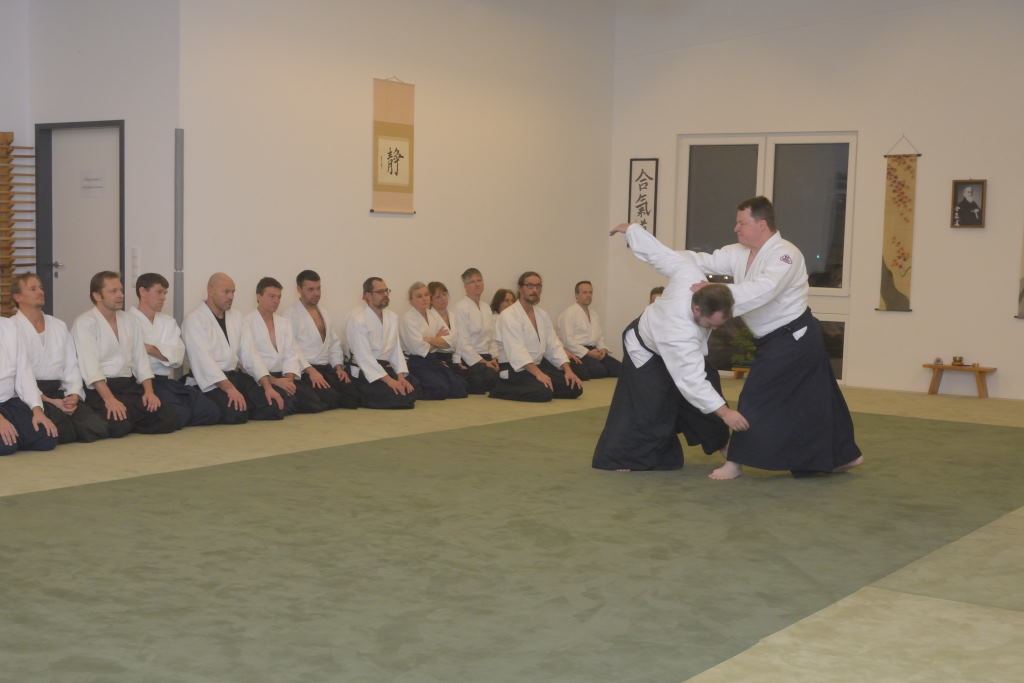The training hours commence with relaxation and warm-up exercises, among them are special breathing and Ki exercises, meditation techniques and Aikido-specific gymnastics (stretching and strengthening as well as relaxation and massage techniques).
In the major part of the education outer and inner principles of Aikido are taught. The outer principles – the technical range of the defence techniques, the sort of attacks and the falling exercises – can be learned quickly when practising regularly. The correct understanding of the inner principles – centralisation in the Hara, straightening up and grounding, flowing of energy (Ki), unification (Ai) of the physical and mental power (Ki) and others – requires a little bit more patience and can only be recognised after a longer training experience.

In the AIKIDO-DOJO FORCHHEIM a close Aikido-trainer-learner-relationship is looked after which does not only make an optimal progress of the learners possible but which also supports the quality of the Aikido-trainer and the quality of Aikido and as a further result makes both achieve fruitful results. The Aikido-trainer, supported by assistants and trainers, accompanies the learners in their development. On the other hand the learners act as a kind of control instance for the Aikido-teacher and make a contribution to his further development that way.
In order to guarantee serious studies the beginner gets the Dojo etiquette (Reigi) conveyed, such as correct behaviour, mutual respect and appreciation, modesty, which besides the Aikido-trainer-learner-relationship count to the major parts of the traditional Aiki path (Do).
For further support of the teaching goals levels of development (Kyu) for the beginners and levels of experience (Dan) for the advanced are established which learners can take examinations on.
The goals of the Kyu levels consist of the teaching of basic techniques (throwing and locking techniques) and the basic movements (turns, pivots, shifts, entering, avoiding and others) as well as the falling techniques (rolling and falling without getting hurt). Besides this technical programme the learners are mediated the development of an understanding of the inner principles, that means they work on the stance and „getting conscious“ of their body. „Getting conscious“ in Aikido means to perceive the centre of the body, to feel and keep the centreer of gravity of the body, to be balanced (tension-relaxation-relationship), to keep the weight down, …
The learners on Dan levels have already found access to the „right stance“ (natural, upright posture, grounding, centralisation, transparency and others) and to the right attitude (mindful, straight, serious and others) when entering the Aikido path. They realise with growing experience how to develop and practice the flowing power (Ki no Nagare), the power of breathing (Kokyu-Ryoku). Technically it comes to a improving refinement of the technique. Variations and combinations become possible.
Part of the teaching goals in the Dan section are also the extension of basic principles of Aikido (centering in the Hara, straightening up and grounding, flow of energy, accordance of breathing and movement flow and others) in order to make it possible with advanced practice to unify Ki, mind and body (Ai) and to bring the own Ki in accordance with the universal Ki. By way of this harmonisation spontaneity, presence (Nen), creativity (Takemusu-Aiki) and true effectivity arise in practice and it comes to a unity of understanding and practice (Ri-Ai).